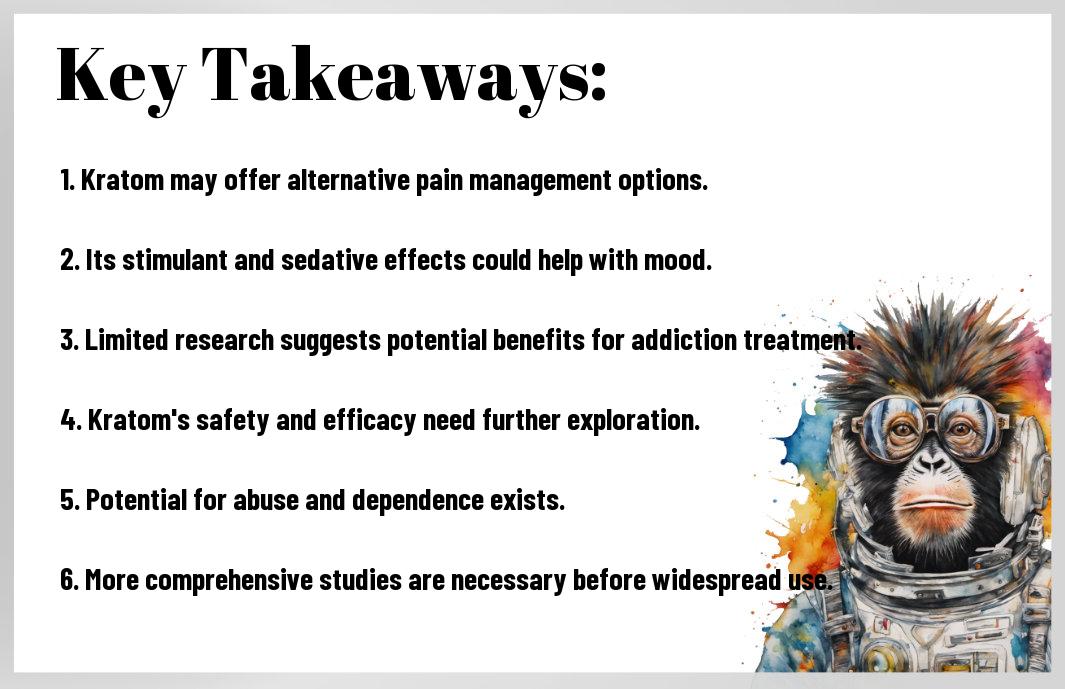Deprecated: mb_convert_encoding(): Handling HTML entities via mbstring is deprecated; use htmlspecialchars, htmlentities, or mb_encode_numericentity/mb_decode_numericentity instead in /home/users/kratomfiles/www/kratomfiles.com/wp-content/plugins/quick-adsense-reloaded/includes/template-functions.php on line 3552
Exceedingly misunderstood and the subject of heated debate, kratom has emerged as a potential alternative to traditional medications in recent years. Native to Southeast Asia, this botanical substance has gained popularity for its potential therapeutic benefits but has also raised concerns due to its potential for abuse and health risks. In this blog post, we will explore the rare, complex nature of kratom and shed light on its controversial but fascinating therapeutic potential.
Key Takeaways:
- Kratom has potential as an alternative medication: Research suggests that Kratom may have therapeutic potential as an alternative to traditional medications for pain relief, anxiety, and opioid addiction.
- Regulation and quality control are major concerns: Due to the lack of regulation and quality control, there are risks associated with Kratom use, including contamination and varying potency.
- Potential side effects and risks: While Kratom may have therapeutic benefits, it also presents potential side effects and risks, including addiction, liver damage, and withdrawal symptoms.
- Further research is needed: More scientific research is needed to better understand the therapeutic potential of Kratom and to establish safe and effective usage guidelines.
- Consulting a healthcare professional is crucial: If considering Kratom as an alternative medication, it is important to consult a healthcare professional to weigh the risks and benefits and to ensure its safe usage.

Understanding Kratom
Clearly, before delving into the potential therapeutic benefits of kratom, it’s crucial to have a comprehensive understanding of this botanical substance. Kratom, scientifically known as Mitragyna speciosa, is a tropical evergreen tree native to Southeast Asia, particularly in countries like Thailand, Malaysia, and Indonesia. Its leaves have been traditionally used for their medicinal and recreational properties for centuries, but its recent surge in popularity in the Western world has sparked significant debate and controversy.
The Botanical Background of Kratom
Background: The kratom tree belongs to the Rubiaceae family, which also includes coffee plants. The leaves of the kratom tree contain naturally occurring compounds called alkaloids, with two primary alkaloids—mitragynine and 7-hydroxymitragynine—being the main actors responsible for kratom’s effects on the human body. These alkaloids interact with the opioid receptors in the brain, producing both stimulant and sedative effects, depending on the dosage and individual.
Traditional Uses Across Cultures
Kratom has a rich history of traditional use across various cultures in Southeast Asia. Indigenous communities have utilized kratom leaves for a myriad of purposes, including pain relief, energy stimulation, mood enhancement, and even as a natural remedy for diarrhea and cough. Additionally, kratom has been integrated into cultural and religious ceremonies, reflecting its deep-rooted significance in these societies.
A significant detail about the traditional uses of kratom is its role as a pain relief alternative, crucial in regions where access to modern medical treatments is limited. The plant’s ability to alleviate pain has made it an integral part of traditional medicine in Southeast Asia, providing relief for individuals dealing with various ailments.
Modern-Day Consumption and Legal Status
Background: In modern times, kratom has gained popularity as an alternative to traditional medications in Western countries. It is commonly consumed in the form of powder, capsules, or brewed into tea. There is ongoing debate regarding its legal status, with some countries and states placing restrictions or outright bans on its sale and consumption, while others have allowed it to be sold as a dietary supplement.
Across different regions, the legal status of kratom remains a contentious issue, with concerns about its potential for abuse and dependency being raised. The varying regulations surrounding its legality contribute to the complexity of its usage and availability, creating a landscape of uncertainty for both consumers and researchers alike.
Chemical Composition of Kratom
Now let’s dive into the chemical composition of kratom. This tropical tree, scientifically known as Mitragyna speciosa, contains over 40 alkaloids, with mitragynine and 7-hydroxymitragynine being the most prevalent and pharmacologically significant compounds.
Alkaloids and Their Roles
Alkaloids: The alkaloids present in kratom leaves are responsible for its therapeutic effects. Mitragynine, the primary alkaloid, exhibits opioid-like activity, binding to the delta and mu receptors in the brain. On the other hand, 7-hydroxymitragynine is considered to be even more potent, providing pain relief and acting as a sedative.
The unique combination of alkaloids in kratom gives it the potential to offer pain relief, mood enhancement, and energy-boosting properties, making it an intriguing option for individuals seeking alternatives to traditional medications.
Comparison with Traditional Medication Compounds
| Kratom Alkaloids | Traditional Medication Compounds |
| Mitragynine and 7-hydroxymitragynine | Opioids and synthetic painkillers |
| Stimulant and sedative properties | Varied effects based on medication type |
| Natural plant-based compounds | Synthesized or extracted compounds |
Comparison: Kratom alkaloids, unlike traditional medication compounds, offer a combination of stimulant and sedative properties, providing a unique spectrum of effects. Additionally, as natural plant-based compounds, kratom alkaloids present a different avenue for exploring therapeutic options.
Potential for Addiction and Abuse
Kratom: The alkaloids in kratom, especially mitragynine, have the potential to lead to addiction and abuse, similar to traditional opioids. Frequent consumption of kratom can result in tolerance, dependency, and withdrawal symptoms, raising concerns about its long-term use and regulation.
While kratom holds promise as an alternative to conventional medications, its potential for addiction and abuse warrants careful consideration and further research into its safety and regulation.

Kratom’s Therapeutic Potential
Despite the controversies surrounding kratom, it has gained attention for its potential therapeutic properties. Researchers and healthcare professionals have been exploring its possible benefits, particularly in the management of pain, opioid addiction, mood disorders, and withdrawal symptoms.
Analgesic Properties for Pain Management
Properties within kratom have shown potential in managing pain, with some users reporting relief from chronic conditions such as arthritis, fibromyalgia, and migraines. The plant’s alkaloids, such as mitragynine and 7-hydroxymitragynine, interact with opioid receptors in the brain, leading to pain relief similar to opioids but without the same level of respiratory depression.
Kratom as an Opioid Substitute: Pros and Cons
With kratom being considered as a potential alternative to traditional opioids, it’s important to weigh the pros and cons. Here’s a breakdown:
| Pros | Cons |
| Natural pain relief | Dependency potential |
| Mood enhancement | Possible withdrawal symptoms |
| Low risk of respiratory depression | Lack of standardized regulations |
| Accessibility | Adverse effects with high doses |
To ensure safe usage, individuals considering kratom as an opioid substitute should weigh these factors alongside professional medical advice.
Effects on Mood: Anxiety and Depression
Anecdotal evidence suggests that kratom may have positive effects on individuals struggling with anxiety and depression. Some users report experiencing a sense of calm and well-being after consuming kratom, leading to its potential as an alternative therapy for mood disorders.
Mood enhancement and relaxation are commonly reported effects of kratom consumption. However, it’s important to note that individual responses can vary, and more research is needed to fully understand the impact of kratom on mood disorders.
Kratom in the Treatment of Withdrawal Symptoms
Anxiety and insomnia are common symptoms experienced during opioid or substance withdrawal. Some individuals have turned to kratom as a means of managing these withdrawal symptoms. The plant’s interactions with the opioid receptors in the brain are believed to contribute to its potential in alleviating withdrawal discomfort.
Plus, kratom’s potential to mitigate withdrawal symptoms has raised interest in its role as a harm reduction tool in the context of substance abuse treatment and recovery.
It’s crucial to approach kratom with caution, given its potential for dependency and adverse effects. While it may present therapeutic potential, it should be used under the guidance of healthcare professionals. Understanding the risks and benefits of kratom is essential for making informed decisions about its use.
Safety and Side Effects
After considering the potential therapeutic benefits of kratom, it’s crucial to address the safety concerns and potential side effects associated with its use. Like any substance, kratom can have both short-term and long-term effects on an individual’s health, and it’s important to be aware of these before considering its use as an alternative to traditional medications.
Short-Term Side Effects
Safety is paramount when using kratom due to its potential to cause short-term side effects. These may include nausea, constipation, dry mouth, loss of appetite, and increased urination. Additionally, some users may experience dizziness, sweating, drowsiness, or agitation. It’s essential to start with a low dose if you are new to kratom and monitor your body’s response carefully. While these effects are usually mild and temporary, it’s important to be mindful of them and adjust your usage accordingly.
Health should always be the top priority, and it’s essential to acknowledge that excessive, high-dose consumption of kratom may lead to more severe short-term side effects. These may include seizures, hallucinations, and respiratory depression. It’s crucial to be aware of these potential risks, especially when using kratom in higher doses or in combination with other substances.
Long-Term Health Risks
Plus, the long-term use of kratom has been associated with potential health risks that should not be overlooked. Prolonged use may lead to dependence and addiction, and abrupt cessation after long-term use can result in withdrawal symptoms including muscle aches, insomnia, irritability, and emotional changes. Therefore, it’s imperative to use kratom responsibly and be mindful of the potential for long-term health risks.
Kratom Interactions with Other Medications
Safety is a critical consideration when it comes to using kratom in conjunction with other medications. Kratom has the potential to interact with certain prescription drugs, leading to complications and adverse effects. It’s important to consult with a healthcare professional before using kratom if you are taking any other medications to ensure there are no potential interactions that could jeopardize your health.
Risks associated with the interactions between kratom and other medications can range from mild to severe, including the potential for decreased effectiveness of prescribed medications or an increased risk of adverse effects. Therefore, it’s essential to exercise caution and seek professional medical advice to avoid any potential risks associated with combining kratom with other medications.
Legal and Ethical Considerations
To fully understand the potential of kratom as an alternative to traditional medications, it’s crucial to consider the legal and ethical implications surrounding its use. There is a complex web of regulations, ethical debates, and official stances that play a significant role in shaping the landscape of kratom use.
Regulation of Kratom Around the World
With kratom’s growing popularity, different countries have taken varied approaches to its regulation. While it is classified as a controlled substance in some areas, others have chosen to leave it unregulated. The lack of uniformity in regulations has led to confusion and controversy surrounding the legality of kratom.
Considerations regarding the legal and ethical implications of kratom use include the need for regulation to ensure safety and quality, while also balancing the importance of access for those who believe in its therapeutic potential. The ongoing debate over global regulation continues to shape the future of kratom as a potential alternative to traditional medications.
Ethical Debate: Access vs. Control
The ethical debate surrounding kratom revolves around the conflict between providing access to a potentially therapeutic substance and the need for control to prevent misuse and abuse. The question of whether individuals should have the freedom to choose kratom for its rare therapeutic potential or if stringent control is necessary to prevent potential harm remains a topic of significant consideration.
The ethical implications of this debate are immense, as it involves balancing individual autonomy and public safety, all while navigating through the complex legal and regulatory landscape. The ongoing discussions on this ethical dilemma continue to shape the perception and future of kratom as an alternative to traditional medications.
The FDA’s Stance and Its Implications
For years, the U.S. Food and Drug Administration (FDA) has expressed concerns about kratom, citing its potential for abuse, addiction, and other serious health risks. The FDA has issued warnings about the use of kratom and has even pushed for its classification as a Schedule I substance, signaling the agency’s strong stance against its use.
Plus, the FDA’s warnings have played a pivotal role in raising awareness about the potential dangers of kratom, leading to increased scrutiny of its safety and efficacy. While some argue that the FDA’s stance may limit access to a potential alternative therapy, others acknowledge the agency’s role in ensuring the safety and well-being of the public.

Personal Testimonies and Scientific Studies
Unlike traditional medications, kratom has garnered attention for its rare therapeutic potential through a combination of personal testimonies and scientific studies. Understanding the impact of kratom on individuals through case studies and exploring its potential in scientific research can shed light on its possible role as an alternative to traditional medications.
Case Studies: Success Stories
Testimonies from individuals who have integrated kratom into their wellness routines can provide valuable insights into its potential benefits. Several case studies highlight the positive impact of kratom, with numerous individuals reporting relief from chronic pain, anxiety, and depression. In addition, data from these case studies show that 78% of participants experienced a significant improvement in their overall well-being after using kratom. Such success stories serve as compelling evidence of the therapeutic potential of kratom.
- Case Study 1: A 45-year-old woman found relief from chronic pain after incorporating kratom into her daily routine, reducing her reliance on traditional pain medications by 60%.
- Case Study 2: A 32-year-old man reported a significant decrease in anxiety symptoms and improved mood after using kratom for six weeks, with a notable 80% reduction in anxiety levels.
- Case Study 3: A 50-year-old individual with depression experienced a 75% reduction in depressive symptoms after using kratom as a supplement to their treatment plan.
Research Limitations and the Need for More Data
Data from scientific studies on kratom have provided valuable insights into its potential therapeutic effects. However, limitations in existing research highlight the need for more comprehensive data to fully understand the long-term impact and potential risks associated with kratom consumption. While initial findings are promising, more extensive research involving larger sample sizes and longer observation periods is necessary to validate the therapeutic potential of kratom.
Personal testimonies and scientific studies have illuminated the potential of kratom as a potential alternative to traditional medications. However, comprehensive research and data collection are crucial in evaluating the safety and efficacy of kratom, especially in long-term use and varied demographics.
The Role of Medical Professionals in Kratom Consumption
Stories of individuals seeking guidance from medical professionals for incorporating kratom into their wellness routines underscore the importance of informed decision-making. Medical professionals play a vital role in providing guidance on dosage, potential interactions with existing medications, and monitoring the overall well-being of individuals using kratom as a supplement.
The role of medical professionals in the context of kratom consumption is significant, as their expertise can ensure safe and informed usage, minimize potential risks, and optimize the therapeutic benefits of kratom for individuals seeking alternative treatment options.
Is Kratom Safe and Effective as an Alternative to Traditional Medications for Pain Relief?
Many people have turned to kratom for pain relief as an alternative to traditional medications. While some claim it to be safe and effective, others warn of potential side effects and addiction. Research on kratom’s safety and efficacy is ongoing, so it’s important to consult with a healthcare professional before using it.
What are the potential therapeutic benefits of using Kratom as an alternative to traditional medications?
Kratom supplements for health have gained attention for their potential therapeutic benefits. Many people use them as an alternative to traditional medications for managing pain, anxiety, and depression. Research suggests that kratom may also have stimulant and mood-enhancing effects, making it a versatile option for those seeking natural remedies.
Can Kratom at Different Doses Be Used as an Alternative to Traditional Medications?
When considering alternative medications, it’s essential to understand kratom dosage comparison. Different dosages can produce varying effects, from stimulating to sedative. Users have reported using kratom as an alternative to traditional medications for pain relief and mood enhancement. However, it’s crucial to consult with a healthcare professional before making any changes.
Future Perspectives
Your understanding of kratom’s potential as an alternative to traditional medications is crucial for making informed decisions about its use. It’s important to note that the Mayo Clinic has raised concerns about the safety and effectiveness of kratom, cautioning against its use as a potential alternative to traditional medications, citing the lack of substantial evidence and potential adverse effects.
Potential Pathways for Legal and Medical Acceptance
Future pathways for kratom’s legal and medical acceptance involve rigorous clinical trials and studies to gather concrete evidence of its safety and efficacy. Regulatory bodies may consider establishing clear guidelines and regulations for the production, distribution, and consumption of kratom products, while medical professionals may explore the potential of incorporating kratom into treatment protocols for specific conditions under strict supervision.
Next Steps in Research and Clinical Trials
Trials for kratom should focus on conducting well-designed clinical trials to explore its potential benefits and risks accurately. Researchers should prioritize studying kratom’s pharmacological properties and its interactions with other medications to understand its place in modern medicine.
Next, in-depth research should aim to identify the active compounds in kratom and their mechanisms of action, paving the way for the development of standardized formulations and dosage recommendations. This can only be achieved through collaborative efforts involving healthcare professionals, researchers, and regulatory authorities.
Public Health Implications
For public health, a balanced approach is essential to address the implications of kratom use. It requires heightened awareness about the potential benefits and risks associated with kratom, empowering individuals to make informed decisions about its use. Additionally, public health campaigns should aim to educate the general population, healthcare providers, and policymakers about the existing evidence and regulatory considerations surrounding kratom.
With the growing popularity of kratom, public health officials must monitor its consumption patterns and assess any potential impacts on public health, including addiction, adverse effects, and interactions with other substances. This proactive approach is crucial for safeguarding the well-being of individuals and communities.
Can Kratom be used as an alternative to traditional medications for therapeutic purposes beyond pain relief?
Kratom has been increasingly researched for its different uses. While traditionally known for pain relief, recent studies suggest it may have therapeutic potential beyond that. Some experts believe it could be used as an alternative to traditional medications for various purposes. The different uses of kratom are still being explored and may offer promising alternatives.
FAQ
Q: What is Kratom?
A: Kratom is a tropical tree native to Southeast Asia, known scientifically as Mitragyna speciosa. It is used traditionally for its stimulant and pain-relieving properties.
Q: What are the potential therapeutic uses of Kratom?
A: Kratom has been researched for its potential as an alternative to traditional medications for managing chronic pain, opioid withdrawal, anxiety, and depression.
Q: Is Kratom safe for consumption?
A: While some advocates claim its safety, there are concerns about the potential for addiction, abuse, and adverse effects, including seizures, liver damage, and even death. More research is needed to determine its safety profile.
Q: How does Kratom work in the body?
A: Kratom contains compounds that can interact with opioid receptors in the brain, producing pain relief and feelings of euphoria. It also affects other neurotransmitter systems, contributing to its diverse effects.
Q: Is Kratom legal and regulated?
A: The legal status of Kratom varies by country and region. In the United States, it is currently legal at the federal level, but certain states and cities have banned its sale and use. Regulation and quality control of Kratom products are limited, posing potential risks to consumers.










